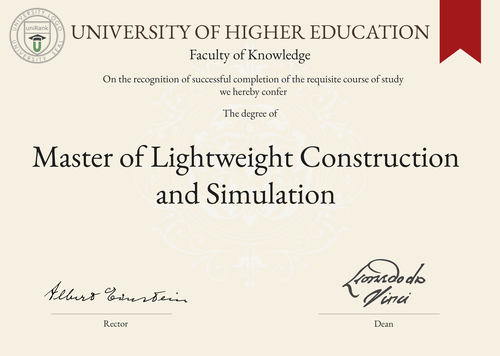
Master of Lightweight Construction and Simulation (M.LCS)
Guide to Master of Lightweight Construction and Simulation Program/Course/Degree
Master of Lightweight Construction and Simulation (M.LCS)

Program Name
Master of Lightweight Construction and SimulationProgram or Degree abbreviation
M.LCSDuration range
1-2 yearsTuition range
Varies by country and universityOverview
The Master of Lightweight Construction and Simulation program is designed to provide students with advanced knowledge and skills in the field of lightweight construction and simulation. This program focuses on the development and application of lightweight materials and structures, as well as the use of simulation techniques to optimize their performance.Curriculum Overview by year
Year 1: - Introduction to Lightweight Construction - Materials and Manufacturing Processes - Structural Analysis and Design - Simulation Methods and Tools Year 2: - Advanced Lightweight Materials - Advanced Simulation Techniques - Lightweight Design and Optimization - Research ProjectKey Components
- Lightweight materials and their properties - Manufacturing processes for lightweight structures - Structural analysis and design principles - Simulation methods and tools for optimization - Advanced lightweight materials and their applications - Research project in the field of lightweight construction and simulationCareer Prospects
Graduates of the Master of Lightweight Construction and Simulation program can pursue various career paths in industries such as automotive, aerospace, renewable energy and construction. Potential job roles include lightweight design engineer, simulation engineer, research and development specialist and project manager.Salary Expectations
Salary expectations for graduates of the Master of Lightweight Construction and Simulation program can vary depending on factors such as location, industry and level of experience. On average, professionals in this field can earn a competitive salary, with the potential for growth as they gain more experience and expertise. For a more accurate understanding of salary expectations, you can utilize the Job Sites Search Engine, from our sister site jobRank, which searches over 4,600 job sites worldwide. Make sure to specify not only the job title but also the country you are interested in.Conclusions:
It is important to note that the duration, tuition fees, curriculum, key components, career prospects and salary expectations of the Master of Lightweight Construction and Simulation program can vary depending on the chosen country or location of study, as well as the chosen university. Prospective students are advised to research and compare different programs and universities to find the best fit for their individual goals and circumstances. Furthermore, visitors interested in pursuing this specific degree can utilize the uniRank World Universities Search Engine to search for universities offering the Master of Lightweight Construction and Simulation program anywhere in the world. This tool provides a comprehensive database of universities and their programs, allowing individuals to find the most suitable options for their educational journey.World Universities Search Engine
search for Master of Lightweight Construction and Simulation (M.LCS) and add the Location (country, state etc.) or specific University you are interested in studying at.
Query examples:
- Master of Lightweight Construction and Simulation (M.LCS) United States
- Master of Lightweight Construction and Simulation (M.LCS) United Kingdom online
- Master of Lightweight Construction and Simulation (M.LCS) Australia international students
- Master of Lightweight Construction and Simulation (M.LCS) University of California
- Master of Lightweight Construction and Simulation (M.LCS) University of London tuition fees
- Master of Lightweight Construction and Simulation (M.LCS) University of Sydney scholarships
Share Program/Course
Interesting? Share this program/course/degree info with your friends now.